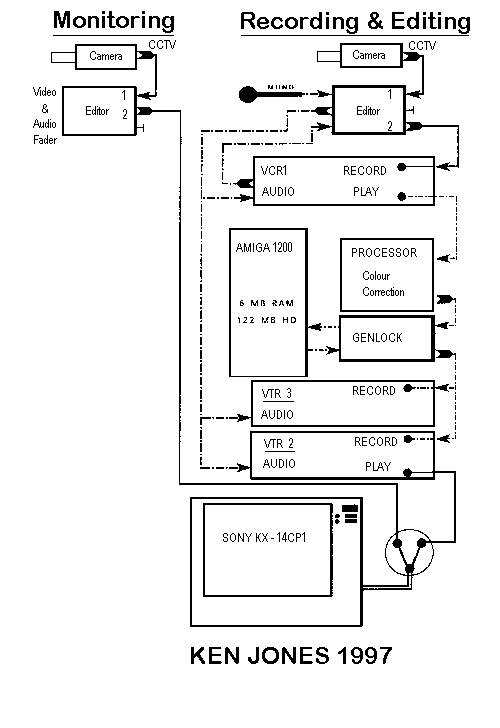
From the first nervous step into this hobby at the tail end of 1987 there have been many different paths and experiments which has led to the system I now use. In conjunction with the printed layout you will be able to follow each item as I mention it.

The camera is a Panasonic WV-CD130 cctv type, now getting on in years but still going strong. The camera output is fed into a video/audio editor with two outputs. I then have a choice of direct feed to the monitor for observations only or going to VCR1 for the full recording /editing system via a separate switch. I find this choice extremely useful because setting up can take from minutes to hours, so saving unnecessary use of electricity. All three video recorders are of Panasonic manufacture, no special reason other than the first one was Panasonic and to retain some kind of compatibility the other two followed suit. They are all of standard domestic quality. VCR1 and VCR3 are mono recorders only, while VCR2 (the last addition) is stereo with insert editing and audio dub.
VCR1 is used to create the master tape, very rarely do I find it necessary to use the processor for any correction of image from the camera and then it is only a matter of switching leads if I wish to do so. The master tape is mainly assembly edited as this is the quickest method of getting the images recorded, here one must be aware of the inevitable loss of quality when copying onto the final edited tape, so it is worth paying attention to every detail in order to get the images as good as you possibly can.
Insert editing will usually give cleaner in and out points but it must be on continuous time coded tape. When filming any live subjects. where you have not the foggiest idea what they are likely to do next, I have found it is almost impossible to use the insert method. If I have got it right, and that can take ages, the master is ready for the next stage which is to add any introductions, information and graphics from the computer.
Using VCR1 to play the tape, my processor will allow any fine tuning for colour correction i.e.. gain / lift and output levels i.e. colour / video / black. This is then passed into the genlock to synchronise the video signal with the computer signal. Having previously prepared the computer program it should be just a matter of running one with the other at the right time into VCR2 for the final version. I have included a second recorder on rare occasions to produce two copies, ref. VCR3. I manage with only one monitor so the image I see all the time is the final one. All the above action should have given me the final visual image and after a thorough check of all detail now is the time to think about adding the narrative with any background music.
Many dry runs will be required for this, patience and a strong heart are useful attributes to have at any stage but most of all now. To help the narrative process I find the easy way is to write all the paragraphs down on paper, then persuade Bette to record them on audio tape. After each section is spoken a pause of four seconds is added before the next section, it is then easy to audio dub onto VCR2 / VCR3 using the pause control on the tape deck and feeding this into the audio editor, NB, tape deck not shown.
There is one gadget I have not mentioned which has proved very useful when putting together sections of film from different tapes. Film taken at different times under various conditions will invariably mean the contrast and light intensity can vary considerably, so I had made an electronic LED indicator connected to a light sensitive cell, the cell can be held in place on the monitor screen in any position with blue tack. I then set the LED scale to mid reference point and then match the next sequence as near as possible to avoid a drastic change in brightness.
There is no denying the pleasure that can be had from a microscope and to share that pleasure with many people makes the effort so much worth while.
Comments on the article to the author Ken Jones, 6 Gumbrells Close, Guildford, Surrey, GU3 3NG, England
Please report any Web problems
or offer general comments to the Micscape Editor,
via the contact on current Micscape Index.
Micscape is the on-line monthly
magazine of the Microscopy UK web
site at Microscopy-UK